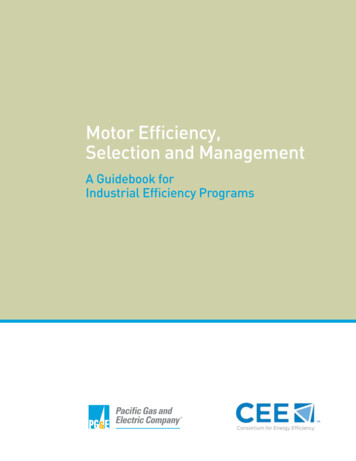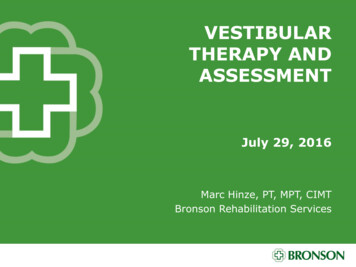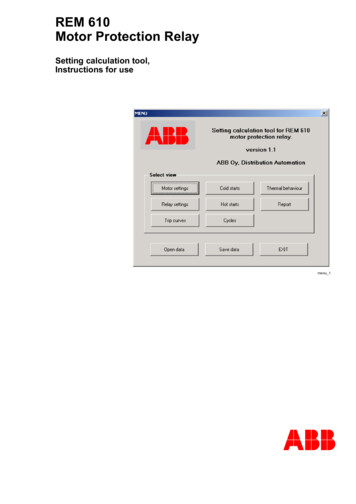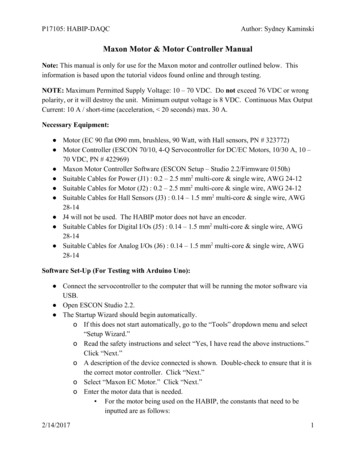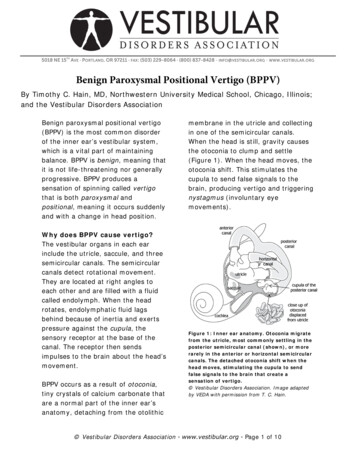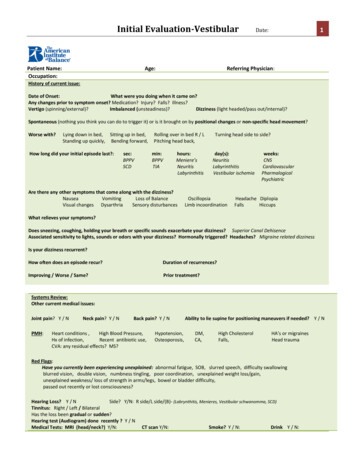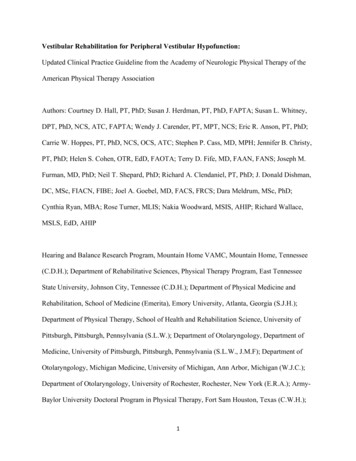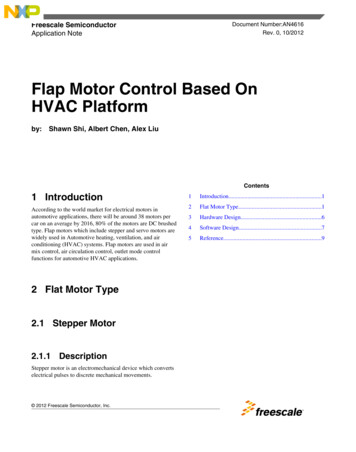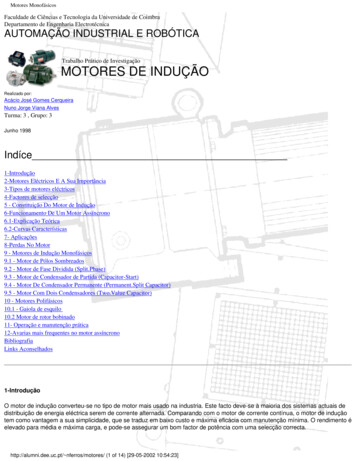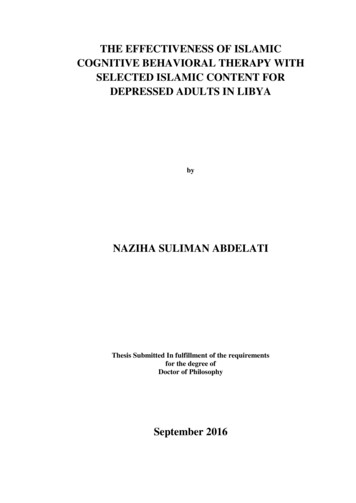
Transcription
Physical Medicine and Rehabilitation ResearchResearch ArticleISSN: 2398-3353Vestibular therapy improved motor planning, attention,and balance in children with attention deficit hyperactivitydisorders: a randomized controlled trialSedigheh Farokhi Moghadam1, Hojjat Allah Haghgoo1*, Ebrahim Pishyareh1, Enayatollah Bakhshi2, Nima Rezazadeh3, Reza Rostami4 andVahid Sadeghi5Department of Occupational Therapy, School of Rehabilitation, University of Social Welfare and Rehabilitation Sciences, Tehran, IranDepartment of Biostatistics, University of Social Welfare and Rehabilitation Sciences, Tehran, Iran3Department of Audiology, School of Rehabilitation, University of Social Welfare and Rehabilitation Sciences, Tehran, Iran4Department of Psychology, Faculty of Psychology and Educational Sciences, University of Tehran, Tehran, Iran5Department of Psychology, Faculty of Education & Psychology, Shahid Beheshti University Tehran, Iran12AbstractIntroduction: Considering the crucial role of the vestibular system in motor and cognitive functions.Methodology: To investigate the effects of vestibular therapy on the motor and cognitive improvements, 63 children with attention deficit hyperactivity disorderswere assessed for eligibility. A total of 38 participants (19 female and 19 male), with 7-12 years of age, were recruited and randomized to receive vestibular therapyreferred as an experimental group. Moreover, another group of participants, referred to as control group, received no intervention for the same time period. Interventionimplemented for two months, 3 sessions per a week, with each session lasting for 30 minutes. All the subjects were evaluated using the the Bruininks-Oseretsky Test ofMotor Proficiency, Integrated Visual and Auditory Continuous Performance Test, and the Cambridge Neuropsychological Test Automated Battery before and afterintervention and data were analyzed using analysis of covariance.Results: Vestibular therapy improved motor performances (P 0.006), response control (P 0.016), auditory (P 0.012) and visual (P 0.012) attention, and motorplanning (p 0.02) in the experimental group.Conclusion: Vestibular stimulation was effective in improving motor skills, response inhibition, attention, and motor planning in children with attention deficithyperactivity disorders.IntroductionChildren with attention-deficit/hyperactivity disorder (ADHD)have a continuous pattern of severe and frequent inattention and/orhyperactivity, restlessness, and failure in academic achievement [1,2].Some researchers suggested that the inappropriate use of cognitivestrategies to solve problems and regulate behaviors is associated withattention deficit [3-6]. Behavioral dysregulation, as a difficulty ininhibiting maladaptive behaviors such as hyperactivity, impulsivityinattention, and aggression) [7,8], about equal to the impairment inexecutive function [9,10]. Executive function is an umbrella term that isused to explain cognitive processes underlying functions such as motorplanning, memory, attention, problem-solving, reasoning, responseinhibition, cognitive flexibility, multi-tasking, initiating, organization,and monitoring the functions [11]. Researchers believe that somecomponents of executive functions are insufficient in people withADHD. Especially, these children have more difficulties in attentionspan, sustained attention, response inhibition, organization, workingmemory, and motor planning [12,13].About 47% to 69% of these children have motor disorders [14]including problems in gross and fine motor skills, motor coordination,and motor control, which are mostly related to attention deficit severityand ADHD symptoms [15-18]. Furthermore, accompanying withPhys Med Rehabil Res, 2018doi: 10.15761/PMRR.1000171motor control problems, these children also show significant balancedisorders. Almost, about 30% to 50% of these children suffer from poorbalance and low coordination [19]. Our previous research showed thatabout 60% of children with a combined type of ADHD suffer fromvestibular dysfunction [20,21].Motor and postural control disorders are explainable with sensoryprocessing dysfunction especially in relation to vestibular system [22].Vestibular system deficiency manifests itself as an imbalance in posturalcontrol muscles’ activation, which causes an inappropriate posturalcondition. This postural imbalance will lead to severe cognitiveproblems such as problems in paying attention to the task, which ismore common in children with ADHD [23]. According to sensoryprocessing approach, many disruptive behaviors in ADHD childrenare compensatory reactions to stimulate the vestibular system [24]. Inthis approach, neural systems involved in processing and integrating*Correspondence to: Hojjat Allah Haghgoo, Department of OccupationalTherapy, University of Social welfare and Rehabilitation Sciences, Tehran, Iran,E-mail: h.haghgoo@yahoo.comKey words: vestibular therapy, cognition. attention, motor planning, ADHDReceived: April 21, 2018; Accepted: April 28, 2018; Published: April 30, 2018Volume 3(2): 1-6
Moghadam SF (2018) Vestibular therapy improved motor planning, attention, and balance in children with attention deficit hyperactivity disorders: a randomizedcontrolled trialsensory modalities control both executive functions and motorbehaviors such that to provide a substrate for the adaptive behaviors[16]. The sensory modalities include (but not limited to) visual,auditory, tactile, olfactory, kinesthetic, proprioceptive, and balance orvestibular senses. When the neural system is unable to process andintegrate certain information from the sensory modalities, it results insensory processing dysfunction [18]. Therefore, sensory informationmay receive naturally, but affect motor and cognitive performances inan abnormal way [15]. Approximately, 16% of the normal populationshave symptoms of sensory processing disorder, while the prevalenceof these symptoms in children with ADHD is within 40-84% [25-27].One class of the sensory processing disorder subtypes is sensory-basedmotor disorders including disturbances in body posture (problemswith balance and core stability) and dyspraxia (problems in planningand sequencing of movements) [15,24].movement exercises [31,32]. Exercises were modified in considerationof the age of the subjects and their balance abilities and attentioncapacities to enhance gaze stability, postural stability, and dailyliving activities. The rehabilitative intervention was conducted by anoccupational therapist research assistant for two months, 3 sessions perweek, and each session lasting for 30 minutes, while the subjects in thecontrol group participated only in their usual academic education. Theyreceived the same VRT program for two months after post-assessmentas an ethical consideration.Considering the dysfunction of the vestibular system in ADHD[20,21], some researchers reported the effects of vestibular stimulationon hyperactivity symptoms in these children [28,29]. In these reports,the researchers focused mainly on hyperactivity symptoms, whilemotor problems including balance, muscle strength, and fine and grossmotors are not addressed. Furthermore, the impact of interventions onthe subclasses of executive function, as the underlying cause of ADHD,has not been investigated.Intervention protocolRegarding the vital role of sensory processing as the basis for theexecutive function, the prominent role of vestibular system in sensoryprocessing [25], and the powerful effects of vestibular stimulationon mechanisms underlying motor control [30], we proposed thattherapeutic exercises with an emphasis on vestibular stimulation toimprove the motor and cognitive performances in the children withADHD. Overall, we investigated the effects of vestibular stimulation onthe motor and cognitive functions in children with ADHD.Materials and methodThis study was approved by the ethical committee of the Universityof Social Welfare and Rehabilitation Sciences, Tehran, Iran, ethics’ codeUSWR.AC.IR.1392.114. Moreover, a written informed consent wassigned by all participants’ caregivers (parents) before the study. A totalof 63 children with ADHD aged 7-12 years old were recruited from thepediatric outpatient clinic of XXX Rehabilitation Center, XXX. Theywere diagnosed as children with ADHD based on psychiatrist interviewaccording to DSM-IV-TR.All the subjects were referred to an audiologist and occupationaltherapist to assess their vestibular function. Having at least two positivetests from the below-mentioned assessments were considered asinclusion eligibility. Assessment tools for inclusion criteria included theWechsler Intelligence Scale for children (WISC-V) – to confirm normalIQ (minimal IQ 90), Vestibular Evoked Myogenic Potential – Rotarychair testing, and Oculomotor Tests [20]. The existence of significantmedical or neurological disorders (such as depression, anxiety, learningdisorder, epilepsy, deafness, and visual problems) was considered asexclusion criteria.Of 63 assessed subjects, 38 participants (19 female and 19 male),recruited and randomized using numbered containers to receivevestibular therapy during academic education (19 subjects, M 10 andF 9) were referred as the experimental group while those with academiceducation (19 subjects, M 9, F 10) was referred to the control group.All subjects in the experimental group participated in acomprehensive Vestibular Rehabilitation Therapy (VRT) program[31] containing overall balance and gate, postural stability, and eyePhys Med Rehabil Res, 2018doi: 10.15761/PMRR.1000171Before and after the intervention period, all the subjects wereassessed using the Bruininks-Oseretsky Test of Motor Proficiency(BOTMP), IVA-plus, and CANTAB (Stock of Cambridge or SOCsubtest) to evaluate the effects of the intervention on motor andcognition functions.(Vestibular Rehabilitation Therapy) was developed and approvedby rehabilitation professionals including occupational therapy andaudiology faculty members according to the vestibular sensory stimuli,which stimulate the semicircular channels, utricle, and saccule organs[32-36]. This protocol includes vestibular exercises for central andperipheral vestibular structures. Intervention protocol was done byan occupational therapist. General vestibular exercises were appliedfor all subjects in the experimental group in the first halftime of eachsession; however, in the second half, exercises were tailored to eachparticipant according to vestibular disorders diagnosed during balanceand vestibular assessments. These exercises targeted mainly on eitherperipheral or central vestibular disorders [36].Subjects in both groups were evaluated using the BOTMP,Integrated Visual and Auditory Continuous Performance Test, andCambridge Neuropsychological Test Automated Battery before andafter the intervention. All assessments were done by examiners blind tosubject’s assigned group.Assessment toolsThe Wechsler Intelligence Scale for children Fifth Edition(WISC-V): The test provides five primary index scores (i.e., VerbalComprehension Index, Visual Spatial Index, Fluid Reasoning Index,Working Memory Index, and Processing Speed Index). This testwas developed by David Wechsler in New York [37]. The test-retestreliability of WISC-V has been reported in the range of 44% to 94% andsplit-half reliability coefficients of subtests were from 43% to 94% [38].Testing was conducted by a trained clinical psychologist to generate afull-scale IQ.Bruininks-Oseretsky Test of Motor Proficiency (BOTMP):Researchers use this assessment battery to collect a comprehensiveindex of fine and gross motor skills for children aged 4.5 to 14.5 yearsold. This tool consists of 8 subscales. Four subtests evaluate gross motorskills (running speed and agility, balance, bilateral coordination, andpower), 3 subtests assess fine motor skills (response speed, visual-motorcontrol, and upper limbs speed and dexterity), and a subtest assessesboth gross and fine motor titled upper limb coordination [39].CANTAB testCANTAB test is composed of a series of neuropsychological tests.This tool was developed at the University of Cambridge computerto assess the cognitive components especially those related to thefrontal and temporal areas of the brain. The battery consists of 22neuropsychological tests in the cognitive domains, such as motor skills,Volume 3(2): 2-6
Moghadam SF (2018) Vestibular therapy improved motor planning, attention, and balance in children with attention deficit hyperactivity disorders: a randomizedcontrolled trialvisual attention, visual/spatial memory, working memory, decisionmaking, response control, executive function, and attention. All testsare non-verbal and their validity has been evaluated by various studies[36]. In this study, we analyze two subtests; the Motor Screening test(MOT) to screen the subjects’ eligibility for test and Stockings ofCambridge (SOC) to assess subjects’ executive function.The Motor Screening test (MOT): The MOT is applied to calm thesubject and familiarize him/her with computer and touch screen in aplay-form activity. First, the subject learns to point by the index fingeron a cross appears on the screen (i.e., to touch it). The test simultaneouslyscreens visual problems, movement disorder, and comprehension,and determines whether students follow simple instructions or not.If the Z score is between 1 and -1, the person is able to be assessedby CANTAB test; otherwise, the child has auditory or visual problems[40]. In fact, the outcomes of this measure are the speed of response andthe accuracy of pointing. It is noteworthy that all subjects were able tofollow instructions and their Z score was in the acceptable range.The Stocking of Cambridge (SOC) was originally introduced as atest of executive function. This test requires the ability to plan spatialand strategic motor programs and measures the frontal lobe’s function.In this test, the screen is divided into upper and lower halves by ahorizontal line. In the upper half, three columns with different numbersof circles of different colors appear in a special pattern. In the bottomhalf, different numbers of colored circles are placed in three columns ina pattern different from the pattern of the upper half. To run the test,the subject should move colored circles in three columns of the lowerhalf of the screen to match the pattern on the upper half and reconstructthe upper half. Fewer numbers of movements to complete the patternindicates the higher ability of subject in motor programming. Theprogram reports average time to think before acting and the smallestamount number of movements to run the test as scores on this subtest.The difficulty of levels increases by reaching the smallest amount ofmovementss needed to complete the work reaches five movementsto two movements. The time spent to reconstruct the pattern andnumber of movementss required will consider as a measure of the firstprogramming ability of subject [40,41].Integrated Visual and Auditory Continuous Performance Test (IVA Plus): The IVA Plus is a test of attention that consists of two stimulimodalities; i.e., visual and auditory. This test was designed to measuretwo important domains: attention and impulse control. This test doesnot make a diagnosis but helps the examiner to make a diagnosis. Theprimary use of this tool is to help the diagnosis of Attention DeficitHyperactivity Disorder; however, it can also be applied to evaluateother attention disorders, and problems with self-control related tohead injury, sleep disorders, depression, anxiety, learning disabilities,dementia, and other health problems. The tool measures the responseto 500 intermixed auditory and visual stimuli spaced 1.5 seconds apart.The program presents stimuli in a random order so that the subject isnot able to predict the next stimulus. The test is applicable for childrenfrom 6 years and older and adults. Testing along with instructions andtraining takes about 20 minutes. The task is composed of response ornon-response (response inhibition) to 500 visual or auditory stimuli.The subject sees visual stimuli on the screen and hears auditory stimuliby headphone. The display time for each visual stimulus is 167 MSand for each auditory stimulus is 500 MS. Here, the task is to click themouse when the stimulus is either an auditory or a visual “number1” and to refrain from clicking when the stimulus is an auditory or avisual “number 2”. The variables reported by this test are the number ofcorrect answers, the number of non-responding to (omitting) the targetstimulus, the number of responding to non-target stimuli (commissionPhys Med Rehabil Res, 2018doi: 10.15761/PMRR.1000171error), and reaction times in the milliseconds. IVA Plus test is usedto evaluate the inhibition of response after a period of consecutiveresponses. So, it needs a sustained and continuous attention. Thepsychometric results indicate a sufficient sensitivity for the test as 92%and 89% to correct diagnosis of ADHD in children. Furthermore, testretest reliability for different parts of the test is reported to be 59% to93% [42,43].Intervention protocol was developed and approved byrehabilitation professionals including occupational therapy andaudiology faculty members according to the vestibular sensory stimuli,which stimulate the semi-circular channels, utricle and saccule organs.This protocol includes vestibular exercises for central and peripheralvestibular structures used for experiment group [32,34,35]. Thesetraining exercises include overall balance exercises such as jumping ontrampolines, lying and sitting on the therapy ball, maintaining balancestanding, sitting, squatting, etc. on a tilt board, taking different positionslike standing, kneeling and crawling on rotating boards or scooters,walking on the balance beam, linear and rotational movements backand forth, left and right on a normal swing, passing over the obstacle,rolling, simple and difficult moves backward [34], stability exercises likestanding on one leg with eyes open and closed [32], standing with feetin tandem, moving back and forth, staring and standing while changinglegs width, exercise with head lights, head spin, rotating the headtrunk, turning heads while walking, practicing on the ramp, goingup and down stairs, saccadic eye movements using eye gaze stability,simultaneous vestibular and somatosensory inputs [33], simultaneoususe of visual and vestibular inputs, using all sensory information forpostural control, and using all senses to control the body position.Data were analyzed using SPSS version 20 software. Leven testand t-test were used to examine the consistency of data. KolmogorovSmirnov test was used to evaluate the normal distribution of data.According to the results, with respect to the normal distribution ofdata, parametric tests (analysis of covariance) were used to compare theimpact of interventions on changes in the two groups. The significancelevel for all tests was 0.05.ResultsStudy populationA consolidated Standards of Reporting Trials (CONSORT) flowchart.Totally, 63 children with ADHD were assessed for eligibility.Twenty-five subjects were excluded because of not meeting inclusioncriteria. Thirty-eight participants (19 females and 19 males) wererandomized to receive vestibular therapy and education (19 subjects,M 10, F 9) referred as an experimental group and receive onlyeducation (19 subjects, M 9, F 10) referred as a control group. All theparticipants completed the post-test evaluations.The mean of ages was an 8.95 1.68 year in experimental group and8.63 1.46 year in the control group with no significant differences inage or gender. The results of Leven Test for equality of variances andT-Test for equality of mean BOTMP’s scores showed no differencesbetween the two groups before intervention.Then, the normal distribution of test scores of BOTMP wasmeasured in both groups using Kolmogorov-Smirnov test; and theresults indicated that all data were distributed normally (P 0.05). Theimpact of the intervention on the BOTMP’ scores in participants.Volume 3(2): 3-6
Moghadam SF (2018) Vestibular therapy improved motor planning, attention, and balance in children with attention deficit hyperactivity disorders: a randomizedcontrolled trialAs can be seen in vestibular rehabilitation therapy resulted in asignificant improvement in balance (P 0.001), and also in the totalgross motor abilities in the experimental group compared to the controlgroup (P 0.006). A subset analysis of total gross motor skills showedthat while running speed and agility (P 0.89), bilateral coordination(P 0.41), and strength (P 0.99) did not show significant changein the intervention group compared to control group, a significantimprovement in balance resulted in significant improvement in thetotal gross motor abilities (P 0.006). Furthermore, the analysis ofindividual subtests showed that visual motor control was improvedsignificantly in the intervention group when compared to the controlgroup (P 0.007) while the subtest of total fine motor skills revealed nosignificant difference in the two groups (P 0.123). In addition, the totalscore of BOTMP has changed significantly in the intervention group incomparison with the control group (P 0.006).According to vestibular rehabilitation program resulted insignificant improvements in response control (p 0.016), visual vigilance(p 0.012), and auditory vigilance (p 0.012) in the experimentalgroup compared to the control group. Furthermore, the effects of theintervention on motor planning are presented.According, vestibular stimulation resulted in significant changesin the SOC scores in the experimental group compared to the controlgroup (p 0.02). In contrast, the mean initial thinking time after theintervention (latency) showed no significant changes between the twogroups after intervention (p 0.72).DiscussionIn the present study, children with a combined type of ADHDreceived vestibular stimulation for two months. The interventionimproved significantly their gross motor skills, balance, and visualmotor control in comparison with the subjects in the control group.Furthermore, the intervention resulted in significant increases inresponse control and visual vigilance while a significant reduction inauditory vigilance (a marker of inattention) [44]. Finally, CANTABevaluation results showed that vestibular therapy resulted in a betterfunction of motor planning. However, in the present study, there wasno significant change in fine motor, running speed and agility, bilateralcoordination, and strength in the intervention group compared to thecontrol group.Vestibular system and motor functionAcquiring motor coordination, development of balance, movementin space, visual-motor integration, and visual-motor coordination areall dependent on the normal function of the vestibular system [45]. Thevestibular inputs activate vestibular nuclei in the brainstem, and thesenuclei are projected to basal ganglia via posterior intralaminar nucleiand effect on cortical regions such as premotor cortex and parietalcortex [46]. Furthermore, there are connections between vestibularsystem and cerebellum in one side and with different brain corticesas well as connections between the vestibular system and other partsof the central nervous system including the thalamus, which explainsthe effects of vestibular stimulation on executive function and motordevelopment skills [47]. Previous studies have shown that caloricvestibular stimulation activates the cerebellar outputs to the prefrontaland visual cortex [46]. In addition, vestibular stimulation in childrenwith cerebral palsy resulted in the significantly improved developmentof gross motor skills and motor coordination [44]. Furthermore, theeffects of vestibular stimulation and sensory-motor activities resultedin calming and hyperactivity control in children with ADHD and thePhys Med Rehabil Res, 2018doi: 10.15761/PMRR.1000171improvement in gross motor skills [48]. Different brain structuresincluding cortex, right inferior frontal regions, the left sensorimotorcortex, basal ganglia, cerebellum and bilateral vermis, right cingulatecortex, and brainstem on both sides are involved in the etiology ofADHD [49,50]. It could be implied that dysfunction in these areascan result in poor postural control (hypotonia, or hypertonia, poorcontrol of limbs, and balance), problem in motor learning (learningnew skills, motor planning, coping with changes, and automation), andpoor sensory-motor coordination (coordination between/within limbs,the sequencing of motor activities, using feedback to correct motion,timing, predicting and planning strategies). Therefore, it may beconcluded that vestibular stimulation resulted in modulating vestibularinputs to widespread brain structures involved in motor control andimproved motor activities in the studied children.Finally, according to CANTAB results, vestibular therapy resulted insignificant improvement in motor planning abilities. Motor planning orpraxis is the brain’s ability to receive, organize, and perform unfamiliaractivities [51]. In motor planning disorder, affected person loses theability to carry out new activities, even though motor and perceptualcapacities are intact. Vestibular system and its projections to cerebellumplay an integral role in motor planning, and any vestibular disordercan cause defects in motor planning [51]. Therefore, it seems that thevestibular system plays a major role in motor planning and motorcontrol systems. This effect could be either by vestibular effects onconsciousness system, and increasing attention, decreasing impulsivityand modulating feedback loops, or in an interaction with cerebellumand proprioceptive inputs.Vestibular system and Cognitive functionOne of the main reasons for impulsivity in children with ADHDis their problems in controlling response to sensory stimuli, whichresult in impulsivity and hyperactivity [52,53]. It is assumed that someADHD symptoms are due to reticular formation dysfunction. Thissystem processes information received from sensory pathways throughwidespread connections [54] and change the level of consciousness andarousal by the effect on the projection of sensory information to thethalamus and from there to the cortex. Accordingly, another theory thatarises in this context relates to the hypothesis that intra-laminar nucleiof the thalamus are involved in integrating the inputs associated withthe level of consciousness, attention, working memory, control of eyemovements and gaze, and are modulated by vestibular stimulation [46].It seems that this reticular activating system is modified by modulatorysensory stimuli. Connections between vestibular systems with reticularformation involve in regulating consciousness levels and selectiveattention [45,55]. On the other hand, vestibule-cerebellar connections,and vestibular projections to different brain areas including thethalamus may explain the relationship between vestibular inputs andbehavioral regulation [47].In our previous study, a sensory integration program with anemphasis on proprioceptive and vestibular senses resulted in a decreasein symptoms of ADHD [29]. In accord with our findings, rotationalvestibular stimulation improved significantly the scores of hyperkineticchildren in Connors questionnaire and a significant reduction inthe symptoms of Attention-Deficit/Hyperactivity [28]. Researchersalso reported that hyperactivity behaviors were reduced significantlyafter semicircular canals stimulation [56]. It seems that vestibularstimulation changes the level of consciousness and probably, modulateconsciousness system which resulted in orienting the child’s attentionto the environmental stimuli, affects correct response to stimuli, andprevents impulsivity.Volume 3(2): 4-6
Moghadam SF (2018) Vestibular therapy improved motor planning, attention, and balance in children with attention deficit hyperactivity disorders: a randomizedcontrolled trialIn order to control coordinated fine and rapid movements, sensoryinformation from somatosensory, visual and vestibular systems mustbe integrated to interpret complex sensory environments and providethe information necessary to control and coordinate these movements.The sensory information from the somatosensory, vestibular, and visualsystems are integrated. Moreover, the relative weight applied to each ofthese inputs depends on the goals of motor tasks and environmentalcontexts. As the sensory environment of individuals changes, therelative dependence on each sensory system must be re-measured.For example, healthy people rely on somatosensory (70%), vision(10%), and vestibular (20%) information in an appropriate illuminatedenvironment with a stable support basis [21].The control of quick and fine movements is a complex skill that takesplace based on the interaction of dynamic sensory-motor processesand includes many basic physiological systems that can be influencedby pathology or clinical constraints. Damage to any of the subsystemscreates various disruptions correlated with the affected specialstructures. Effective rehabilitation of balance, coordination, and controlof gross or fine movements require a better understanding of multiplemechanisms of motor control and the provision of pathologically-basedinterventions for each subsystem and consideration of total systemdamages. Therefore, many systems must be evaluated and intervened.At the end, it worth mentioning that only one care provider (anoccupational therapist) offered therapeutic services in this research forall subjects, and she was blind to the research aims. She was qualifiedfor application of vestibular therapy protocol and tailoring the programfor each subject, individually. Secondly, the tester was blind to eachsubject’s allocation group. And the comparator, also, was blind toallocated groups; he only tested differences between the subjects in thetwo group
1Department of Occupational Therapy, School of Rehabilitation, University of Social Welfare and Rehabilitation Sciences, Tehran, Iran . neuropsychological tests in the cognitive domains, such as motor skills, Moghadam SF (2018) Vestibular therapy improved motor planning, attention, and balance in children with attention deficit hyperactivity .
